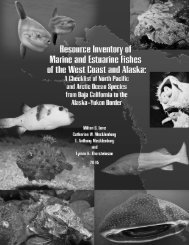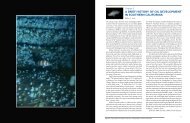Reproductive Ecology and Body Burden of Resident ... - The Love Lab
Reproductive Ecology and Body Burden of Resident ... - The Love Lab
Reproductive Ecology and Body Burden of Resident ... - The Love Lab
You also want an ePaper? Increase the reach of your titles
YUMPU automatically turns print PDFs into web optimized ePapers that Google loves.
Statistical analysis <strong>of</strong> otolith <strong>and</strong> seawater microchemistry<br />
We used univariate <strong>and</strong> multivariate statistics to test for differences in the concentration <strong>of</strong> particular<br />
elements <strong>and</strong> multi-elemental signatures in otoliths <strong>and</strong> seawater among platforms <strong>and</strong> natural habitats<br />
(SPSS, Inc. 2002). Before the statistical analysis, otolith <strong>and</strong> seawater element Ca -1 data were log 10<br />
-transformed<br />
to better fit assumptions <strong>of</strong> the models. Log (x+1) transformation was used on all otolith element<br />
Ca -1 data to account for zero values. Prior to the analyses, we assessed the normality <strong>and</strong> homoscedacity <strong>of</strong><br />
the otolith data among water mass groups (SPSS, Inc. 2002).<br />
We employed a two-way fixed analysis <strong>of</strong> variance (ANOVA) to simultaneously test for the effects <strong>of</strong><br />
habitat <strong>and</strong> geographic area on the abundance <strong>of</strong> an element (element Ca -1 ) in otoliths <strong>of</strong> a single species<br />
<strong>and</strong> to test for interaction <strong>of</strong> these two factors. We also used a one-way ANOVA to test the effects <strong>of</strong> site (all<br />
platforms <strong>and</strong> natural sites) on element abundance in otoliths. We employed the Tukey post hoc multiple<br />
comparison test (or the Tamhane test when equal error variances could not be assumed) to examine differences<br />
between all possible pairs <strong>of</strong> group (e.g., area, site) means (SPSS, Inc. 2002).<br />
Canonical discriminant function analysis (DFA) was used to test whether the elemental signature <strong>of</strong><br />
otoliths identified the habitat types occupied by fish (SPSS Inc. 2002). We used the results from our univariate<br />
analysis to determine the elements that were the best discriminators <strong>of</strong> either habitat types or geographic<br />
areas, <strong>and</strong> included those elements in the DFA. <strong>The</strong> procedure generated a single discriminant function<br />
(DF) for two groups (e.g., two habitat types, platforms <strong>and</strong> natural sites) or a set <strong>of</strong> DFs for more than two<br />
groups based on linear combinations <strong>of</strong> the predictor variables (log (element Ca -1 +1) transformed) that<br />
provide the best discrimination between the groups.<br />
<strong>The</strong> classification accuracy <strong>of</strong> the DFA was evaluated by leave-one-out cross-validation, also called<br />
jack-knife reclassification (SPSS Inc. 2002). <strong>The</strong> prior probabilities <strong>of</strong> group membership were assumed to<br />
be uniform.<br />
We used the Spearman’s rho correlation to determine whether the abundance <strong>of</strong> different elements in<br />
otoliths co-varied <strong>and</strong> whether the abundance <strong>of</strong> an element in otoliths varied with the element concentration<br />
in seawater (SPSS, Inc. 2002). We estimated the correlation between the average otolith element abundance<br />
<strong>and</strong> average seawater concentration at sampling sites using the Pearson product-moment correlation<br />
coefficient, r. If the correlation was significant, we used least squares regression to model the relationship<br />
between seawater element concentration, the environmental predictor, <strong>and</strong> otolith element concentration,<br />
the dependent variable, by fitting a linear equation to the observed data (Systat S<strong>of</strong>tware Inc. 2006).<br />
Kelp rockfish otolith elemental signatures<br />
40<br />
Results<br />
<strong>The</strong> variability in the concentration <strong>of</strong> individual elements in kelp rockfish otoliths differed between<br />
habitat types <strong>and</strong> geographic areas. <strong>The</strong> univariate two-way ANOVA model (habitat x geographic area)<br />
showed that Mg Ca -1 , Sr Ca -1 , <strong>and</strong> Ba Ca -1 differed between platforms <strong>and</strong> natural sites, <strong>and</strong> Sr Ca -1 <strong>and</strong> Ba<br />
Ca -1 differed among geographic areas (Table 2).<br />
Mean otolith Mg Ca -1 <strong>of</strong> kelp rockfish was higher at platforms compared to natural reefs, except in the<br />
ESB area (Fig. 3 A, B). Two-way ANOVA showed a significant difference in Mg Ca -1 between habitat types<br />
(Fig. 3A) but not among areas (Table 2). <strong>The</strong>re was a significant interaction (habitat x area) effect (Table 2)<br />
as indicated by the inconsistency <strong>of</strong> otolith Mg Ca -1 being higher from the natural site in ESB rather than the<br />
platform as in other areas. One-way ANOVA showed that otolith Mg Ca -1 differed among sites (Table 3), <strong>and</strong><br />
otolith Mg Ca -1 was significantly higher from Platform Gilda (OEC) than from natural sites in the same area<br />
<strong>and</strong> the three sites in SCB (Fig. 3B; Tamhane tests, p




